by Elizabeth
Our final stop in the Philippines was one that I had been looking forward to since arriving in the country: Coron. The area is known for its wreck diving and I was eager to see what all the fuss was about. Confusingly, the town of Coron is on Basuanga Island, which is next to Coron Island. The whole area is part of the Palawan Province, but is actually north of the island of Palawan, which is known for its beautiful beaches (which we skipped because we decided that we’ve spent an awful lot of time at beaches for not being beach people).

Looking down on Coron Town.
Getting to Coron ended up being a bit tricky. We had hoped to go earlier on our trip, but all ferries and flights were booked from Manila for a week solid (and of course, we didn’t plan ahead). We ended up flying from Cebu, with an overnight at the Manila airport. So fun!
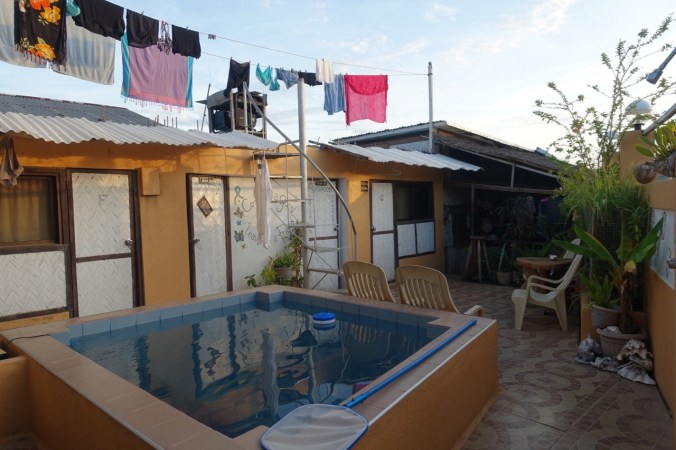
Our guesthouse in Coron Town.
Diving Coron’s Wrecks
We stayed in Coron Town at a simple guesthouse (Patrik & Tezz Guesthouse) and quickly hooked up with Rocksteady Dive Center (also called Reggae Dive Center) to dive the local wrecks (Michael’s Note: this dive shop needs to figure out what it thinks about Jamaican music — is the place Reggae or Rocksteady? They are not the same). Diving with Rocksteady ended up being a great experience. The pricing was cheaper than in Malapascua, running about $70 for a three-tank dive day including gear, lunch, and a couple post-diving drinks (we did pay a bit extra for nitrox tanks though).

Map of the local wrecks from Rocksteady Dive Center.
We have done some limited wreck diving on prior trips, but nothing with particularly extensive penetration into the wreck. Technically, PADI (the organization that we are certified under) requires a special wreck diving certification for wreck penetration, but it turns out that the application of the rules on the ground isn’t so strict (or maybe it’s just that the rules are different when you’re with a Dive Master?). Between our number of logged dives and advanced deep dive and nitrox certifications we were good to go.
Michael and I dove together for two days and then I dove a third day while he took the day off and went running. The dive days were long to allow time to get to the sites and to provide for long surface intervals so that we could maximize bottom time. We left each day at 8am and typically didn’t get back to the docks until 5pm or so.
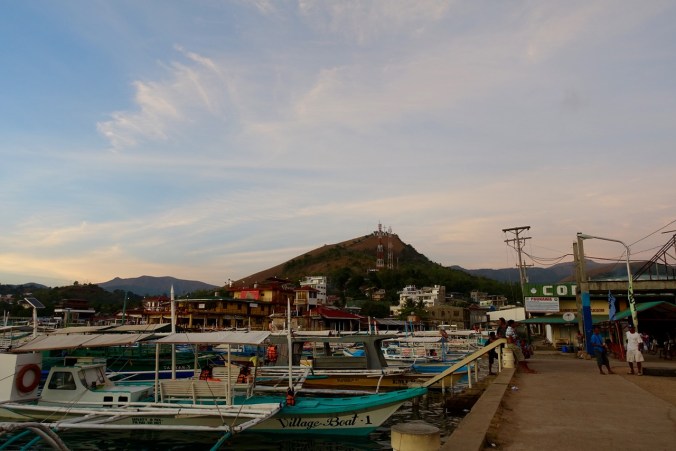
View from the docks at sunset.

We ended up diving a number of the wrecks, including the Olympia Maru, Morazan Maru, Irako, Kogyo Maru, Teru Kaze Maru (“Sangat Gun Boat”), Akitsushima (Navy Sea Plane Tender), and Okikawa Maru (Navy Auxilary Oiler). All of these wrecks were the result of an air-attack conducted by the U.S. Navy against the Imperial Japanese Navy on September 24, 1944. Most of the ships were actually civil cargo ships (supporting the war effort) and the group had sought shelter in the cove area after an attack near Manila a few days earlier. Luckily for divers, the resulting wrecks ended up being just shallow enough for recreational divers to explore!

Diagram of the Olympia Maru wreck. Image credit: Rocksteady Dive Center.
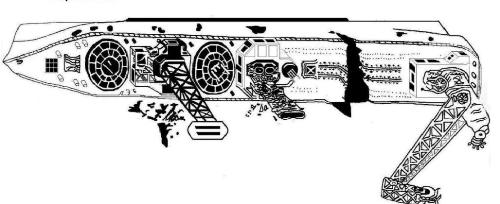
Diagram of the Akitsushima wreck. Image credit: Rocksteady Dive Center.
Once again, we weren’t taking underwater photos. I’ve found a few online (photo credit noted), but honestly I think that these were the kind of dive sites that would have been incredibly difficult to photograph. Visibility was generally poor, at about 5-10 meters. There were a couple times during our descents where I couldn’t see the massive ship that we were headed towards until I was literally only a few feet above it. The poor visibility wasn’t as important once we were inside the wrecks because the spaces were fairly small. For an idea of what diving the sites was like, I found some awesome YouTube videos and an interesting historical account of the attacks here — check it out if you’re interested.
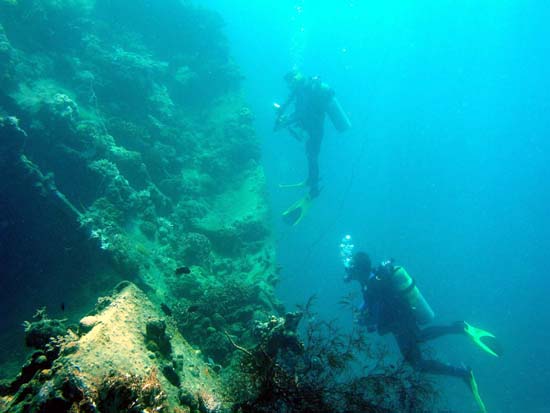
Photo credit: Rocksteady Dive Center.
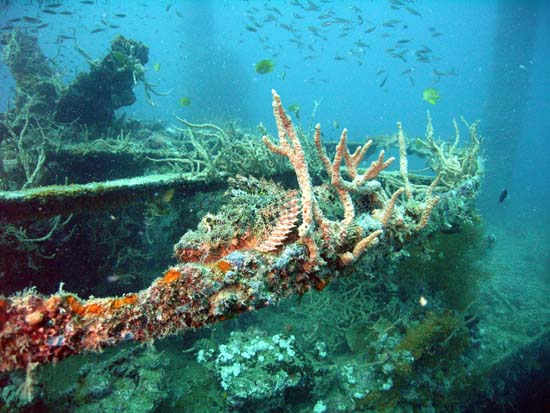
Photo credit: Rocksteady Dive Center.
We spent a majority of each dive inside the various wrecks. While we might enter or exit through the large cargo holds, we also made our way down narrow hallways or through small doorways (or windows?). The temperature of the water was warm enough that I normally wouldn’t have worn a wetsuit, but it was nice to have the extra protection. We had such limited clearance in some places that you couldn’t help but brush your leg against a barnacle-laden door opening. On one occasion, the opening was so small that our dive master literally had to help pull Michael through the opening because there was no clearance between his stomach and tank!! (Michael’s Note: this could have been difficult if I hadn’t lost weight on the trip.) Oh, and of course much of these passages were basically in the dark because we were completely enclosed within the ship. Torches were a must.

Inside one of the wrecks. Check out the piles of rope that still remain! Photo credit: Inquirer.net,
Luckily for most of the dives it was just the two of us and the dive master because we had to go through the wrecks one-by-one and carefully avoid kicking up silt that would obscure the view of the diver behind you. Inside the wrecks we explored the boiler rooms, laundry and kitchen areas, and even saw ammunition storage rooms with lots of ammunition still piled in place. Depending on whether the ship had sunk upright or on its side, everything could end up off by 90 degrees! It was a really interesting experience and very different from any of our prior dives. While there was some interesting sea life inside and on top of the wrecks, the added historical features were incredibly intriguing and it was fun to try to navigate through the various passageways. In one of the wrecks we even got to surface inside the ship in an old air pocket (but were warned to keep our regulators in because the air was nasty)!
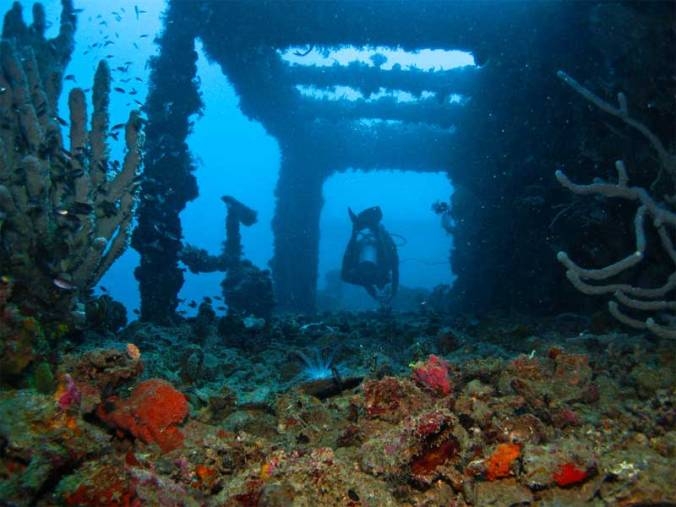
Photo credit: Dive.in
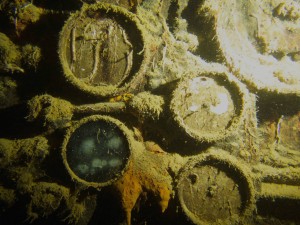
A ship’s dials. One of the wrecks even had portholes that still had intact glass! Photo credit: Inquirer.net.
One of the aspects of the dives that I found most surprising was the type of sea life that we saw around and on top of the wrecks. There were tons of lion fish (often 5 or more bunched together in a small area), lots of scorpion and rock fish, and even several crocodile fish! These are the types of fish that blend in really well with their environment, but there were so many of the wrecks that you were sure to find something interesting to see. I’m not sure if I’d ever seen a crocodile fish before and on a normal dive we’re lucky to spot a single scorpion fish, but here we could spot four or five!
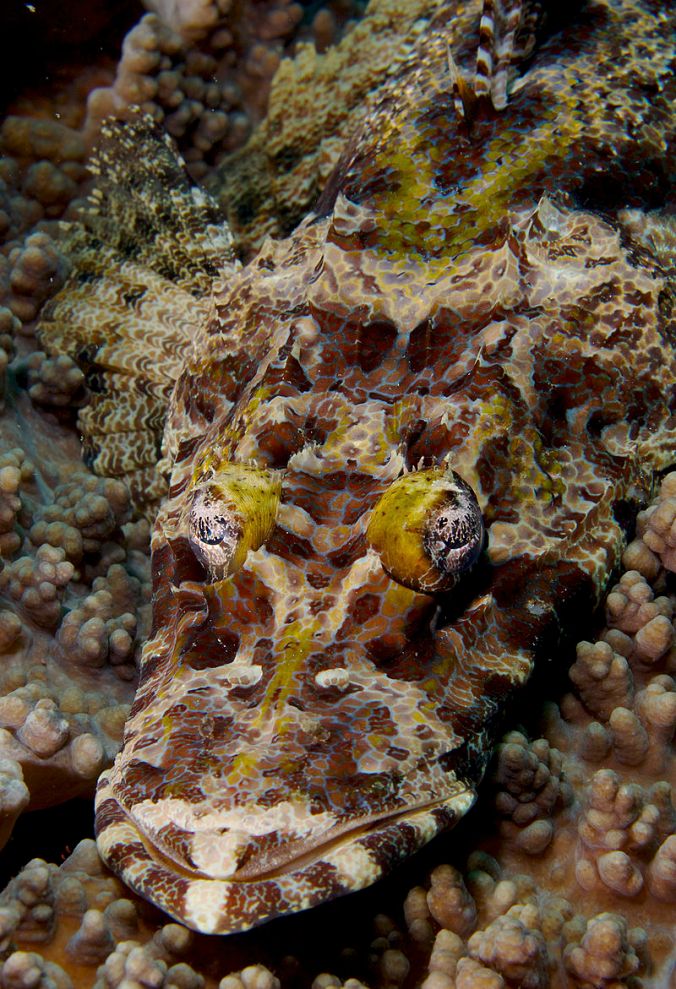
Head on view of a crocodile fish. These guys were awesome. Photo credit: Nick Hobgood.
Most of the wrecks were fairly deep, at about 25-34 meters in depth (82-112 feet). I was glad that we’d kept our dive computers after diving with my parents in Raja Ampat because we had to keep a close eye on our no-decompression limits — I can’t imagine diving without a computer here! Even with nitrox, the dives ended up being relatively short due to decompression limits, but we still typically had time to full explore the wreck before it was time to head up to the surface.
Aside from the wrecks, we also had the opportunity to dive at Barracuda Lake. The lake has a top layer of cool brackish water, but once we descended to around 10 meters in depth we hit a thermocline where the temperature changed and everything become blurry. Once we descend a bit further we hit hot water. Bathtub water hot. I was literally sweating inside my dive mask from the heat. My dive computer had a hard time adjusting to the temperature, but I think that the water was around 39 degrees celsius (102° F)! Of course, with water that hot there was no animal life at depth. I was happy to have experienced the lake’s extreme thermocline, but it ended up being one of the few dives that I have ever been on where I was eager to return to the surface (or at least out of the hot water).
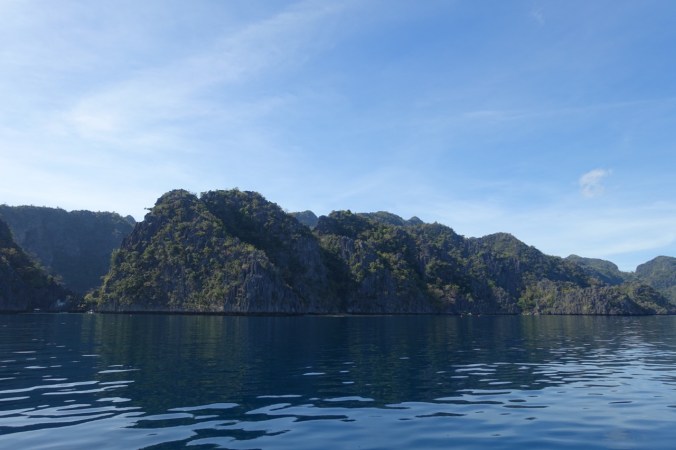
Approaching Barracuda Lake.
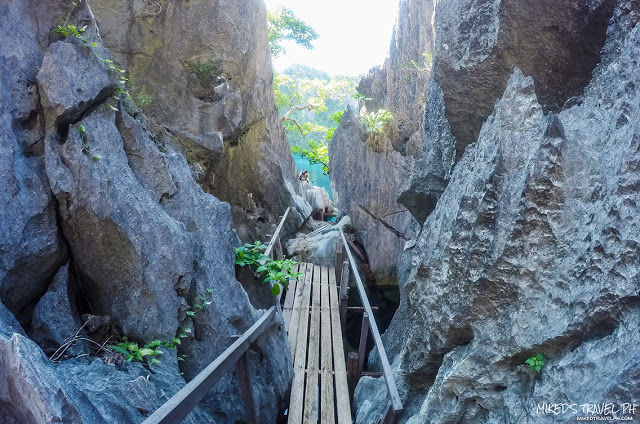
Pathway to cross over to the inland lake… in full scuba gear. Photo credit: Mike D Travel PH

Barracuda Lake. Photo credit: Mike D Travel PH.
And Then This Happened…
To cap off our final day in Coron (and the Philippines) we decided to rent a motorbike and explore the island a bit. We opted to head west from Coron Town, which landed us primarily on interior roads (probably should have headed east for more beach views). On our way back to town, we stopped briefly for a photo opp of one of the few ocean views.
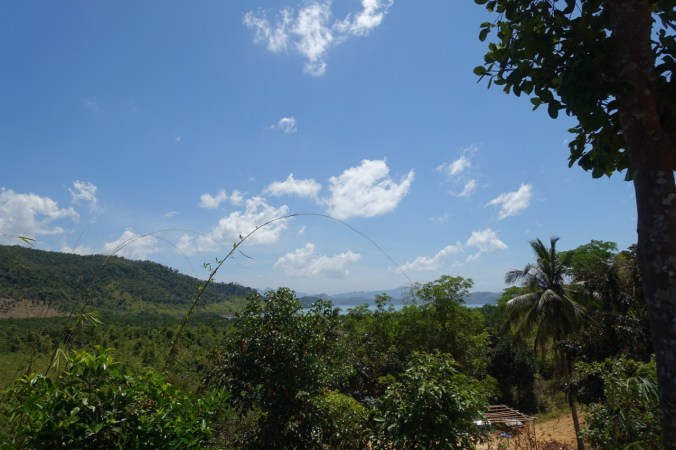
A sliver of ocean… probably not worth it…
I hopped off the back of the motorbike and quickly realized that I’d made a big mistake. It turns out that the bike’s exhaust pipe was hot, huge, and completely exposed. I’d exited on the right and had pressed my inner calf against it for only a brief moment before feeling the heat. We were in the middle of nowhere and it was clear that I needed to get ice on my leg ASAP. Luckily, we found a roadside stand a couple miles down the road that had a bag of ice.
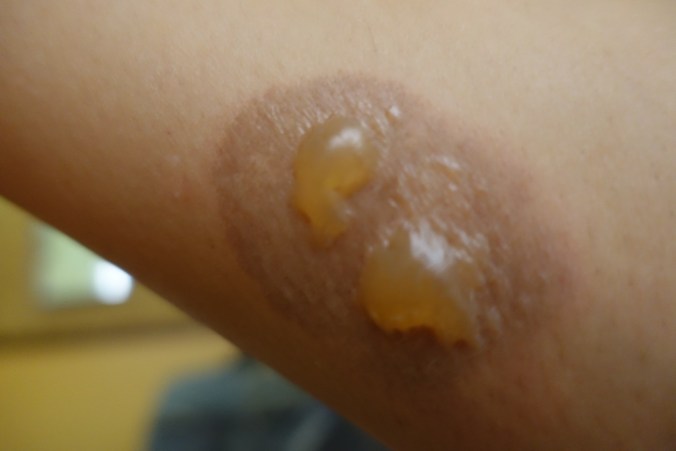
Blister pic taken a few hours later. Sorry, I couldn’t help myself. It got worse before it got better.
After a few hours of fairly intense pain and soaking my leg in cold water (internet suggested that ice was a no no), the pain died down. Still left me in a somewhat unfortunately position of needing to protect the injury from physical contact and germs. And of course, concerns about permanent scarring. Ugh. Just what I needed as we head off to Taiwan (and it’s many thermal hot springs) and then the PCT.
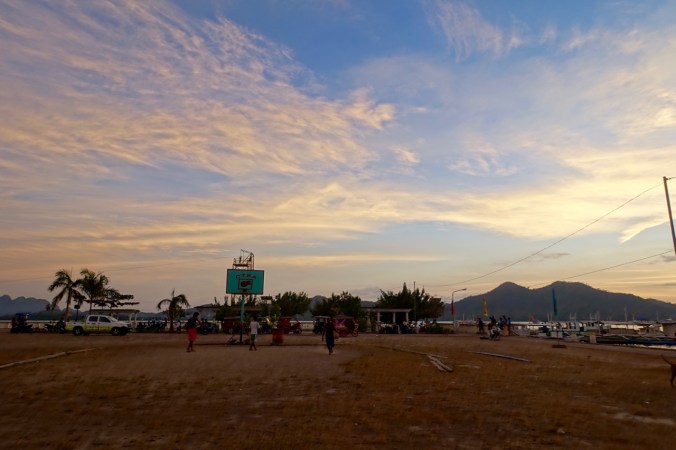
Sunset pick-up basketball game at the port.
And with that, our time in the Philippines was up. We only ended up overstaying our original visa period by a couple of days, but having the additional time at Malapascua and Coron was worth it. Next up… Taiwan!
[This blog post describes our visit to Coron, Philippines from March 2 through 5, 2017.]